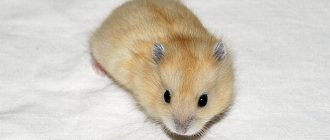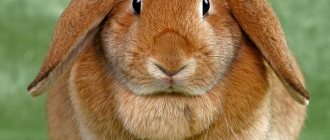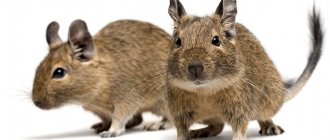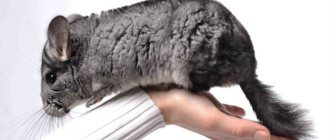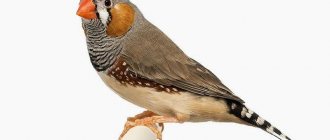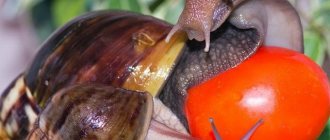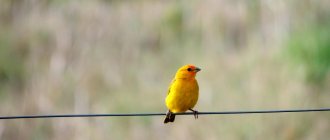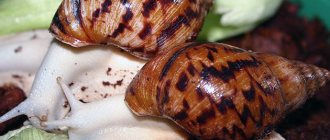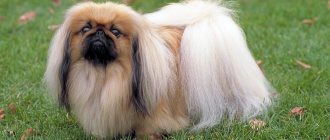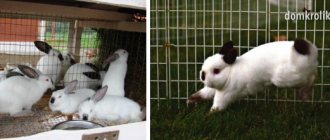Rabbit farming is a profitable and promising business if you approach it responsibly. However, more and more people are interested in breeding decorative rabbits at home, and there are many nuances here. First of all, you need to find out what the age of the animal is. If a male is selected, then individuals younger than one and a half months are not recommended. The best option for a baby rabbit is for it to be moderately well-fed, active, and not show lethargy and drowsiness.
Particular attention should be paid to the pet's fur - there should be no bald spots, it should shine, any pustules and bulges are not allowed. Many people wonder how to care for a decorative rabbit, what is needed for a decorative rabbit, here you need the opinion of specialists. Caring for a decorative rabbit can only be done by those who love this work, and then the question of how to keep them in proper condition will not arise.
Choosing a breed of decorative rabbits for beginner rabbit breeders
There are several breeds of decorative rabbits.
Decorative rabbits are cute and affectionate pets
The following varieties are best suited for the home:
- The Angora rabbit has the longest and fluffiest fur. The breed is divided into several types: Belgian, Australian, French and German. The Belgian is distinguished by its longest fur - up to 8 cm. The animal is characterized by an affectionate, playful disposition. Aggression occurs only in extreme cases.
- Hermelin is the smallest representative of the breed. Weight is within 1-2 kg. It has a thick, shiny, smooth coat of pure white color. Eye color can be blue or red. Hermelin females are distinguished by their capricious character, so this should be taken into account when choosing, especially for new rabbit breeders.
- Fox rabbits get their name from their bright orange coat color. These are affectionate and docile animals, not prone to aggression. Long hair requires careful daily brushing. When pellets appear, you need to cut off the problem areas.
- The dwarf ram grows up to 2 kg. The breed is classified as shorthaired. Its representatives have multi-colored colors and long ears - up to 28 cm. The pet has a peaceful disposition. Good for families with small children.
Decorative rabbits are perfect for apartment keeping - they do not require regular walks outside, have pleasant soft fur and are distinguished by a quiet character.
With proper care and care they can live up to 12 years.
What you need to know when choosing a breed
Before purchasing a rabbit for your home, you should consider the following parameters:
- Body weight - the larger the rabbit, the more it will eat.
- Density and length of fur - long-haired species require careful care of the fur and constant combing.
- Specific features of each type.
Features of rabbits of different breeds
| Breed name | Photo | Peculiarities |
| Short-haired dwarf rabbit | Body weight fluctuates around 1 kg, and color has up to 60 variations. Many people like snow-white animals with dark spots around their eyes. | |
| Dutch | The body weight of an adult animal is 0.5 – 1 kg. The colors are blue, black, brown, gray, with a characteristic color highlight of the eyes, chin, belly, and limbs. | |
| Angora | “Lumps of fur” that require constant care for the fur coat. The color scheme of fur has many variations, but white is especially favorite. | |
| Fox dwarf rabbit | Long-haired animals weighing 1-1.5 kg and different colors (red, chinchilla, agouti). Very playful and affectionate. | |
| Angora lion | The muzzle of the animals resembles the face of a lion. Weight – up to 1.2 kilograms. They require constant trimming and combing of long fur all over the body. | |
| Lion head | Unlike the Angora lion, they have increased furring only on the head and neck. The hair on the body is shortened. | |
| Lop-eared rabbit ram | The length of the coat is medium, and the ears fall down to the sides in a rather funny way. The weight of an adult does not exceed 2 kg. The color scheme is different. They do not require special care. Weight does not exceed 2.3 kg. | |
| Dutch Dwarf Fold | Body weight – about 1.5 kg. The suit is varied. They are considered not picky animals. Very playful, get along well with children. | |
| Pygmy hare | They have an external resemblance to brown hares. Calm, peaceful, friendly pets. | |
| Ognevka | Color: black, brown, blue. This breed has clearly defined nostrils, eyes, belly, chest, and ears. Weight – about 2.4 kg. | |
| Dwarf rex | The structure of the fur is similar to velvet or plush. The specific structure of the fur - if you run your hand over their fur, the hairs will return to their original position. Weight can reach 4 kg, despite its miniature dimensions. This species does not have whiskers. They are considered the calmest and phlegmatic among all dwarf relatives. Suitable for beginner rabbit breeders. | |
| Hermelin | Body weight rarely reaches 1.5 kg. The suit is varied. Very afraid of the heat. By nature - “on your own mind.” | |
| Polish rabbit | Average weight - 1.2 kg. The body is short, deep, from the hips to the shoulders. | |
| Dwarf butterfly | Body weight 1.5-1.8 kg. The coat must be shiny. Color – white with a symmetrical “butterfly” pattern. | |
| Squirrel | Average weight – 4 kg. They are similar in appearance to squirrels, hence the name. Interesting animals with cheerful dispositions. | |
| Minor | They are considered the smallest dwarfs. Weight – up to 1.1 kg. The color varies. Friendly and undemanding in care. | |
| Japanese | A distinctive feature is a special color - different sides have different colors. There are individuals with checkerboard placement of colors on their fur. | |
| Mini Lop | Very “capricious” to care for. Body weight rarely reaches 1.3 kg. Very playful, love children, friendly. |
Who to choose, boy or girl
When choosing the sex of a rabbit, you must take into account your character and capabilities. An active, restless, playful eared boy requires a lot of attention from his owner. He often needs to be walked, played with, caressed and loved. However, boys require a smaller cage and are less likely to become obese.
Female rabbits have a calm character, are more balanced, and cannot tolerate activity and fuss around them. Females love gentle stroking, but they do not like active squeezing. To keep girls, you need to choose cages with a minimum size of 80 cm, and you must take into account that they grow about 250 g more than boys. It is also worth monitoring their diet more carefully to prevent obesity.
| Advantages of keeping a decorative rabbit | Possible problems |
| Silence | Males mark territory |
| Trainable | Remnants of hay often scatter around the cage |
| Discharge their physiological needs in the tray | Can chew wallpaper and wires |
| Feeding the animal is inexpensive | You need to take a walk around the house every day |
| No need to walk outside | Susceptible to many diseases |
| Friendly |
Basics of keeping: cleaning the cage, smell, walks, choosing a place
Rabbits need proper care and attention. Before buying an animal, you should take care of purchasing the necessary equipment and a cage in which it will spend most of its time. You also need to find the right place in the apartment where the pet will be comfortable.
Decorative rabbits are perfect for apartment keeping
Decorative rabbits react painfully to exposure to direct rays, extreme heat and overheating of the body.
The optimal room temperature will be +18…+20 0С with air humidity up to 50%. The air in the apartment should not contain ammonia, carbon dioxide and hydrogen sulfide. Dampness and drafts must be avoided: these factors have a detrimental effect on the health of the animals.
Rabbits do not sweat - heat exchange is carried out through the veins located on the ears. Therefore, during stuffiness, you can wipe your ears with a damp cloth - this will improve your pet’s well-being. A plastic bottle with ice in the cage or a wet towel placed on the cage can help in the heat.
In an apartment, it is better to keep your pet in a cage. It is recommended to avoid socializing with cats and dogs, as the animals are very shy. They need to be held firmly and securely in your hands. If he falls, he might die.
It is recommended to secure a feeder with food, a drinker and a tray in the cage. Rabbits love to play, and loose equipment will serve as a toy, which will create a lot of noise and disorder in the house.
The floor of the cage must be covered with a special bedding, which must be kept dry and made from natural products - sawdust, straw, hay.
It is necessary to change and clean the bedding every 3 days to eliminate the unpleasant odor and prevent gastrointestinal diseases in the animal.
Litter must be removed every day. The baby rabbit will ignore a dirty litter tray and make a new toilet for himself in another place in the cage.
Walking outside is not necessary for rabbits, but in the summer you can take them out to run on fresh grass.
The animal must be wearing a collar with a harness. It is recommended to walk in sunny, windless weather. In winter, only seasoned animals can be taken outside; walking time should not exceed 10 minutes.
Be sure to read:
Breeding rabbits at home for beginners
How to choose a place
You should not place the cage near a radiator or air conditioner, as overheating is unbearable for pets. The most optimal temperature is +20 degrees. We must once again say about the timidity of these animals; they are afraid of everything: dogs, cats, children, TV, vacuum cleaner, computer. The cage should ideally be placed away from the window, where it should be light and calm. If the room is ventilated, then drafts should not be allowed; it is not recommended to place a cage on the balcony; the animals will overheat there.
If rabbits are kept in a private house, then you need an enclosure with a canopy; you can make a small fence so that there is no fear of rain and overheating. In the summer, rabbits happily walk outside, so keeping decorative rabbits is not so difficult.
The cage should be cleaned regularly and the tray should be changed at least once every week. When washing the cage, it is recommended to use a disinfectant; if the cage is located outside, then it must be washed every day. You need to superficially clean the cage every day while the rabbit is walking, it is very convenient to clean. If disinfectants are used, we must remember that rabbits are very sensitive to chemicals, so you need to be careful.
Contents in a cage
The place where the animal is kept should be convenient and comfortable: an enclosure, a house or a cage. The size is selected according to height: standing on its hind legs, the animal should not rest against the ceiling. It is better to make the pallet plastic and put a straw bedding on top.
It is not worth putting sawdust and straw on a pallet, because the baby rabbit will begin to relieve itself everywhere. For the toilet you need a tray filled with natural substances: sawdust, hay, soft paper, leaf shavings or straw.
The place where the animal is kept should be convenient and comfortable
The cage area can be divided: make a separate part for sleeping, eating, playing and toileting. The place to sleep can be slightly darkened, this will ensure comfortable rest and privacy.
It is better to place the feeder, drinker and hay bark separately. It is better to make a feeder for grain feed from a heavy material, such as ceramics. The animal will not be able to knock over the bowl and play with the container, which will prevent severe contamination of the cage. It is allowed to fix the drinking bowl with the feeder on the rods.
You should not keep your rabbit in a cage all the time - this will cause skeletal deformation, obesity or another disease. The animal has an active and playful character, so it requires movement. You need to let him out for a walk around the room at least once a day.
What to buy before a rabbit appears in the house
First of all, to care for your pet eared ear you will need:
- The place where you will keep the decorative rabbit (cage or aviary)
- Dishes (drinker, food bowl, hay box)
- House in a cage
- Litter tray
- Care products
Let's take a closer look at each point.
Cage or aviary
An aviary is an excellent place to keep it, and it’s also easy to care for, but it takes up a lot of space in an apartment. This is a fenced-off space where your decorative pet will live. Make sure that the long-eared animal cannot jump over the fence and that there is additional covering on the floor (for example, you can lay an inexpensive laminate as a second layer), otherwise the animal, grinding off its claws, will make sure that there is no covering left.
Advantages of the enclosure: plenty of space for a decorative animal, easy to care for, good for watching your pet play (children will especially like it). Cons of an aviary: you need a lot of space indoors.
The cage is a compact option for keeping a decorative rabbit in the house. Easy to care for, fits on any table or chest of drawers. An excellent choice for beginners, this is what we recommend.
Pros of the cage: inexpensive, does not take up much space, easy to care for. Disadvantages of the cage: there is not enough space to keep a pet, you need to regularly let it out for walks.
The enclosure is spacious, but you have to sacrifice living space.
How to choose a cage
First of all, focus on size. The minimum area for comfortable keeping of one individual is 50x70 cm. The height is so that an adult ornamental animal can stand on its hind legs without resting on the ceiling. Please note that the size indicated is for decorative breeds. For a “full-size” pet rabbit, you will need much more space (depending on the size of the adult animal).
The most suitable material is steel rods and a plastic tray (it is imperative that it is detachable). A wooden cage is not suitable - a decorative rabbit will simply chew it off. The rods should be without paint - the pet will still chew them, and who knows what they are painted with. A removable tray is needed for ease of maintenance - replacing the filler, washing.
When purchasing, run your palm over the inner surfaces: there should be no burrs or sharp wire edges in the cage. Otherwise, the decorative rabbit may get injured, especially the ears.
This kind of “keeping” is cruelty to animals.
What should be in the cage
We recommend the following items for a decorative pet's cage:
- Small house. Rabbits live in burrows and need a secluded place to hide from prying eyes.
- Tray. It is very inconvenient to care for the cage when the animal relieves itself wherever it pleases; it is better to install a separate tray for the toilet - this will greatly facilitate care.
- Bowl for food. It should either be heavy so that the decorative rabbit does not constantly turn it over, or attached to the bars of the cage.
- Drinking bowl. Installed on rods.
- Branches for grinding teeth (teeth grow constantly).
- Mineral and salt stone. This is not for the teeth, as many people think, but to replenish the decorative rabbit with substances necessary for the body.
Where to install the cage
Basic requirements for the place of residence of a decorative rabbit:
- The cage should not be on the floor
- Avoid any drafts
- The pet’s favorite temperature is 18-20 degrees (extreme heat is especially contraindicated, as rabbits do not sweat)
The cage should be placed in a quiet place - decorative eared animals do not like loud sounds. That is why it is rarely possible to catch them outside - they even sleep very lightly. Accordingly, the kitchen or living room is not suitable for a pet.
Don't disturb your sleep!
How to clean a cage
Caring for the cage does not require much time, but every day you will need:
- Replace uneaten food with fresh food
- Change the water in the drinking bowl
- Add/replace hay
- Change the litter in the tray (this can be done less often, but daily care is better to eliminate unpleasant odors).
At least once a week, a general cleaning of the “room” will be required - disinfection of all dishes and washing of the cage. Do not use products with strong chemicals - this can lead to problems with the gastrointestinal tract of the ornamental animal and even poisoning. Wash with safe options such as vinegar and citric acid.
How to care for a rabbit: care products
A decorative rabbit definitely needs claw care. They grow throughout life and, if not taken care of, furniture and laminate/linoleum will suffer. It is not necessary to buy a special kit for animals; simple manicure scissors and a nail file are enough for care. Have peroxide and cotton wool on hand in case you hit any capillaries.
Domestic rabbits take care of their fur on their own, but there are quite shaggy breeds that will not be harmed by brushing. Buy a special brush for this. Is it possible to use “human”? In general, yes. But you wouldn’t use your own comb to groom your pet. But if you buy it anyway, it’s better to buy a special one for pets.
Decorative rabbits do not regurgitate fur like cats. Therefore, domestic breeds with long hair need to be combed, especially during shedding.
Another item is a special shampoo for caring for your pet. True, decorative eared animals do not like bathing. This is only worth doing:
- if the animal is very dirty
- after illness, diarrhea
- for treatment against parasites (fleas, ticks)
Just don't swim, just don't swim!
Hygiene procedures
A decorative rabbit needs constant care and health care. It is also necessary to follow the vaccination schedule - this will protect against a dangerous disease. You should not treat the animal yourself; it is better to contact an experienced veterinarian.
Nail care
The animal's claws are constantly growing. Veterinarians advise trimming them every 2-3 weeks. You should not leave claws untrimmed because of the risk of injury to the animal or yourself during play.
You need to ask someone for help to carry out the procedure. The animal must be held tightly so that it does not twitch during cutting and damage to the blood vessels at the base of the claw does not occur.
The length of the claws after the procedure is 2-3 mm. If a vessel is suddenly damaged, the bleeding can be stopped with 3% hydrogen peroxide.
Grooming
It is recommended to brush long-haired breeds daily to prevent the formation of tangles. During molting, the combing procedure is increased to 2-3 times a day.
Bathing is prohibited for rabbits. It is allowed to bathe only when the fur interacts with chemical compounds. The animal is cleaned in separate sections.
Rules for treating rabbits at home
To cure a pet, owners use both chemicals and traditional medicine.
Medications
To treat purulent otitis media, antibiotics are used. Good results are observed when using Chloramphenicol and Bicillin. Ciprofloxacin is also used to treat otitis of the inner ear. The course of treatment usually lasts about one and a half months.
To rid the animal of ear mites, local treatment in the form of ointments is prescribed. First of all, the skin is cleaned of crusts and scabs, lubricating the damaged areas with Psoroptol spray. In case of severe spread of the disease, the veterinarian may prescribe subcutaneous injections of the drug “Baymek” and “Decta” drops.
It is also effective to use aerosols in the treatment of psoroptosis. A solution containing chlorophos, neocidol, sulfidophose and cyodrine is sprayed from a distance of 15-20 cm for several seconds. In this case, it is necessary that the medicine gets on the inside of the ear, and the eyes, nose and mouth of the animal are closed.
Folk remedies
Such treatment methods are effective in the initial stages of diseases. If your pets are affected by ticks, you can use camphor oil to irrigate the affected ear areas. The substance is drawn into a syringe without a needle and the skin is carefully treated. You can also use turpentine.
Expert opinion
Zarechny Maxim Valerievich
Agronomist with 12 years of experience. Our best country expert.
Ask a Question
Important! To treat leather, turpentine is diluted with vegetable oil (castor, olive, sunflower) in a ratio of 1:2. It is folk remedies that allow you to gently remove crusts and scabs from the surface of the skin.
A common recipe: glycerin is diluted with iodine in a ratio of 4:1 and the crusts are lubricated once a day (2-3 days). Thanks to iodine, sores are also disinfected. You can also use a mixture of glycerin, kerosene and vegetable oil, taken in equal parts
It is folk remedies that allow you to gently remove crusts and scabs from the surface of the skin. A common recipe: glycerin is diluted with iodine in a ratio of 4:1 and the crusts are lubricated once a day (2-3 days). Thanks to iodine, sores are also disinfected. You can also use a mixture of glycerin, kerosene and vegetable oil, taken in equal parts.
How to properly trim the claws of decorative rabbits at homeRead
What should you buy for a decorative rabbit?
Keeping your pet comfortable will guarantee a long life and reduce the risk of developing diseases.
A comfortable stay for your pet guarantees a long life
You will need to purchase the following equipment at the pet store:
- Tray. Experienced rabbit breeders buy several trays and place them on the floor in the apartment for walking. It is better to choose a toilet with high sides and a spacious one, then the filler will not spill out. One side of the tray is made low for the convenience of the animal.
- Automatic drinker . It is fixed on the grille. Water is served in portions, which keeps it fresh for a long time. You can make it yourself from a plastic bottle.
- Nursery . The hay is placed in special mangers, which are attached to cage links or placed on the floor.
- Grain feeder. You have to buy it heavy; there are models with attachment to a cage.
- Carrying. You will need it for walks and visits to the veterinarian, it can be plastic or in the form of a bag.
- Toys. Rabbits have an active, playful disposition. To maintain your pet’s good mood, you will need to purchase a wheel, labyrinths, mats, etc.
- House. It is worth putting a house in the cage in which the animal will sleep and rest.
- Bedding in a cage. It is better to take from natural materials - hay, sawdust, straw. Thickness is at least 3-5 cm.
- Leash or harness. Useful for walking.
- Combing brush, nail clippers. Necessary for hygiene procedures.
It is recommended to keep all equipment clean: this will eliminate the unpleasant odor.
Conditions of detention
Decorative rabbits need good care. The owner must provide them with proper living conditions. Before purchasing a pet, you need to buy a cage, equipment, and also decide which corner of the apartment will be allocated for it.
Cell selection
The choice of cage must be approached with the utmost seriousness, because the pet will spend most of its life in it. What to pay attention to:
- Size. The home of a decorative rabbit should be spacious - about 4-5 times the size of the pet itself. Inside a good cage there is a tray, a manger for hay, a bowl for food, a house for sleeping, while still leaving free space for the pet to move and play.
- Quality of materials. It is better to give preference to a cage made of metal with a fine lattice; it should not be painted. Plastic cages often contain harmful impurities, which can cause the animal to develop allergies.
- Safety. The rabbit's housing should not have sharp parts, otherwise the animal will be injured.
- Structural strength. The cage should last at least 3-4 years. Don't forget that rabbits will chew parts of their homes.
- Floor. It is best to choose a cage with a smooth floor rather than a lattice floor, otherwise your pet's delicate paws will suffer. Because of the bars on the floor, rabbits sometimes develop a disease called pododermatitis.
Advice. If you plan to keep several pets, then it is advisable to provide each of them with a separate home. It is permissible to keep two castrated males, female rabbits from the same litter, or a female and a male together.
Selecting a location
A decorative rabbit in an apartment will feel comfortable if you choose the right place to place the cage. Eared animals are afraid of cold, drafts and extreme heat. In such conditions they may die. In addition, the animals are shy. This means that the cage should be installed in a secluded place where the pet will be calm.
Rabbit in a cage
Unsuitable places for the cage:
- A walk-through corridor where children run and strangers come in.
- Children bedroom. A child may develop allergies due to constant contact with animals.
- Kitchen.
- Cold loggia. If the balcony is not insulated, the animal will be cold. The optimal temperature for keeping decorative rabbits is from +16 to +24 degrees.
You can put the cage in the living room, where the whole family gathers to relax and communicate together. A glazed and insulated loggia is an excellent choice. No one will disturb the rabbit there, but it is important to make sure that the cage is not in a draft or in direct sunlight. It is better to place the rabbit's home on a low stand or cabinet, rather than on the floor.
Important! The cage must not be installed near an air conditioner or heating radiators.
Additional inventory
In addition to a home, the rabbit will need other equipment that will help him feel comfortable. What items should you buy when deciding to get a decorative rabbit:
- Tray - one or more. One tray is installed inside the cage, the other in the apartment. The toilet should have high sides on three sides so that the filler does not spill out onto the floor. Choose a tray that is spacious so that the rabbit can use it comfortably.
- Drinking bowl. Pet stores sell automatic waterers for rabbits. Their advantage is that they cannot be turned over, they are attached to the cage bars, and the water there remains fresh for a long time. You can make a drinking bowl with your own hands from a plastic bottle.
- Hay manger. Eared ears include hay in their diet every day. The daily intake is a bunch the size of a pet. It is placed in a special feeder. Stores sell mangers that are attached to the cage or placed on the floor. The first option is more convenient.
- Bowl for feed. Rabbits are mobile, so you should choose a heavy bowl that is difficult to tip over. It is worth considering the option of a feeder mounted on the cage wall.
- Carrying. The owner of the animal will certainly need a plastic carrier if he needs to be taken to the veterinarian for an examination or vaccination.
- Toys. The decorative rabbit loves to spend time actively. It is worth placing several toys in the cage, for example, a wheel or various devices - labyrinths, mats. The pet will enjoy playing with them - gnawing, running, disassembling, scratching.
- House for a rabbit. Your pet must have a secluded corner where he can hide from danger or simply relax. A small house is placed in a cage.
Rabbit house
Choosing a cage for a decorative rabbit
The size of a decorative rabbit's cage is 1-1.4 m. A small cage restricts the animal's movement - this will lead to obesity, skeletal deformation and paw diseases. You cannot buy a cage made of plastic.
Be sure to read:
Vaccine for rabbits against myxomatosis and VGBV at home for beginners
The pet is in a cage most of the time. To maintain activity in the cage, you will need a place to play and eat.
A separate area should be designed for sleeping - put up a house or shade it. The animal belongs to the mink breed and can get a good night's sleep in a dark, secluded place. Also, a separate house will be required for a pregnant female; she will build a nest in it.
Cage for decorative rabbit
It is recommended to place the drinking bowl, feeder and manger away from the play area: this will prevent the animal from turning over and injuring itself.
Pregnancy and childbirth
The gestation period for decorative rabbits lasts about a month - this also depends on the age of the female (young females “carry” their babies a little longer).
During such a period, the female needs special nutrition and care. It is necessary to provide her with round-the-clock access to water, healthy food rich in vitamins and minerals. It is recommended to maintain silence in the room, because it is fear from extraneous sounds that often leads to miscarriage.
A pregnant female plucks her down and puts it in the nest
Childbirth in a female rabbit most often begins in the evening, but sometimes during the day. Some decorative individuals require human supervision. So, if the rabbit leaves the nest for a while, then the newborn babies should be covered with down.
Newborn rabbits are completely defenseless and need especially careful treatment. The main principle is to do no harm, so you should study some of the nuances in advance in order to avoid mistakes and associated unpleasant consequences. More details in a special article.
If she completely refuses to feed the offspring, then the breeder will have to do it himself, using dry formula and a special syringe. A female rabbit who refuses to give birth is no longer allowed to breed.
Newborn rabbits
Important point! Some females are already ready for a new fertilization a few days after giving birth. Even when pregnant, they can continue to nurse their young.
Rabbit food
The diet of a decorative rabbit consists of fresh hay with branches, feed and clean water. Compound feed consists of cereal granules with vitamin and mineral additives. Hay must be kept in the manger at all times, but it must be constantly renewed. Consumption of hay stimulates active intestinal function, as well as teeth grinding.
Granules regulate the functioning of the digestive tract, maintain dental health, and replenish the mineral complex. For small rabbits, it is enough to add 1 tbsp. l. 3 times a day. For adults, 1.5 tbsp 2 times a day is enough. l.
Proper nutrition for decorative rabbits
The diet should contain fresh branches of fruit or deciduous trees: this will have a beneficial effect on dental health and replenish the vitamin balance. In winter, conifers are added. The twigs must be washed before giving to the animal.
Pieces of fresh fruits and vegetables serve as vitamins. Exotic tropical fruits should not be given. Along with fruits, you need to enrich your diet with chamomile, yarrow and black peas. Parsley and dill contain essential oils, so they are not fed to rabbits. Herbs with fruits can be given from 4 months of age.
The main thing in your pet’s diet is water ; it is recommended to use boiled water. The water must be clean and fresh, so it is changed daily.
Nutrition
Rabbit with an apple
Decorative rabbits need a balanced, nutritious diet:
- green feed (grass, vegetable tops);
- hay;
- twig food;
- vegetables and fruits;
- mineral and vitamin supplements;
- industrial mixtures.
Important! Decorative rabbits should not be given white cabbage, potatoes, citrus fruits, plums, milk, or sweets.
Diseases and mandatory vaccinations for rabbits
The regular vaccination schedule includes vaccinations against myxomatosis, viral hemorrhagic disease, paratyphoid fever, pasteurellosis and listeriosis.
Improper care can cause illness in an animal. Nutrition also plays an important role in the development and maintenance of the animal.
The animal is susceptible to the following diseases:
- Poor quality food and unsanitary conditions cause problems with the digestive system. Malaise manifests itself as attacks of diarrhea or diarrhea, increased gas formation. There may be mucus with blood in the droppings.
- Temperature violations and strong drafts lead to pathologies of the respiratory system. The pet becomes lethargic and constantly sneezes. Inflamed mucous membranes, frequent breathing, accompanied by wheezing, indicate inflammation of the lungs or bronchi.
- Unsanitary conditions cause conjunctivitis of the eyes.
- Excessive diarrhea accompanied by weakness with a sharp decrease in weight are signs of infection of the animal with worms.
- The presence of fleas results in red spots on the skin, itching and restlessness of the pet.
- Loss of fur in large quantities with signs of bald patches indicates the presence of mites.
- Nodules with bumps present on the body indicate myxomatosis, which is transmitted by mosquitoes, fleas and ticks. The disease can also cause marks on the animal’s body from the claws of a cat or dog.
- Diseases of the genitourinary system can be recognized by traces of blood in the urine.
- Rabbits are susceptible to tumor-like diseases of a benign (fibroadenoma with papilloma) and malignant nature (sarcoma, lymphoma or adenocarcinoma).
- Parasites with bacteria or viruses can cause the development of dangerous pathologies - coccidiosis, salmonellosis, stomatitis, mastitis and others.
If the first symptoms of illness are present, you cannot treat the animal yourself. You need to call a veterinarian at home or take the rabbit to a veterinary hospital. Timely medical assistance will save the health and life of your pet.
The regular vaccination schedule includes vaccinations against myxomatosis, viral hemorrhagic disease, paratyphoid fever, pasteurellosis and listeriosis.
Before traveling to another region, you will need to be vaccinated against rabies. It is recommended to worm the animal regularly: once every 2-3 months.
Pet care
The lifespan of a pet will directly depend on the conditions in which it lives, a balanced diet and quality care.
Feeding
The diet of decorative rabbits will vary depending on age, development period and season. The main condition is balance. In winter, the animal will need to be fed feed and hay. In summer - hay, succulent feed, greens and mineral supplements.
Important! To avoid harm to the health of rabbits, they should not include sweets, sugar, cookies, bread, or pasta in their menu.
Hay should be present in the hay barn around the clock. Compound feed, vegetables, fruits, and grain are placed in the feeder 2-3 times a day. Pregnant rabbits and baby rabbits are fed 4 times a day.
Vegetables suitable for ears are broccoli, cabbage, carrots, and tomatoes. Vegetables are introduced from 3 months of age. The recommended daily intake is 1.5 cups per 1 kg of weight. From greens you can give lettuce, parsley, dill, basil, mint, spinach, celery. Herbs include dandelion, plantain, yarrow, common hogweed, and chickweed. Allowed fruits are apples, apricots, bananas, mangoes, peach, papaya, pear, pineapple. Berries: cherries, wild strawberries, strawberries.
When compiling a daily menu, you need to adhere to the following percentage:
- hay - 80%;
- concentrated feed - 10%;
- vegetables and fruits - 10%.
In pet stores for rabbits you can choose concentrated food in granules, muesli, drops. Special candies are sold as treats.
Games and walks
Rabbits are active animals, so you need to make sure that they walk and play at least a couple of hours a day. For a walk, you will need to fence off a small area, making sure that there are no sockets, electrical wiring, wires - anything that could be dangerous if the animal wants to chew on it. During walks, the pet must be supervised. You can't leave him alone.
Find out how to catch a runaway rabbit.
The rabbit can also walk outside. To do this, you will need to purchase a special vest with a leash.
It is important to provide the animal with toys on which he can grind his teeth. If there are no such people, then the fluffy will chew everything. As toys, you can use branches and special devices sold in pet stores, for example, tunnels, wheels, rodents, playhouses, balls.
It is necessary for the owner to spend at least a couple of hours a day communicating with the pet. If an animal is left to its own devices all day long, it can become withdrawn, depressed, and aggressive.
Important! Before playing with your rabbit, you should wash your hands with soap that does not emit a strong odor. If the animal finds the smell unpleasant, it may bite.
Cosmetic procedures
Cosmetic procedures for domestic rabbits include:
- coat care;
- trimming nails;
- swimming (optional).
Hair care involves combing with special accessories to avoid the formation of tangles. It will be more thorough in long-haired animals. These will need to be combed once every 2-3 days, and also trimmed in places where the fur is too long and interferes with the rabbit’s life. Nail trimming is carried out with a special nail clipper.
Bathing is done as needed - in extreme heat, in case of careless contamination, after a street walk. The rest of the time, the rabbit can take care of its cleanliness itself. Bathing is carried out with a special means. The rabbit is lowered into a basin of warm water, after closing all the windows and vents in the house. Since water procedures for a pet are very stressful, you need to be prepared for him to struggle and scratch. After bathing, the animal should be blotted dry with a towel or blow-dried and combed.
Video: How to trim a rabbit's claws
Cleaning the cage
The rabbit's home, like himself, must be kept clean. You should adhere to the following cleaning schedule:
- 1 time a day - replacing and washing the tray;
- Once a day - wash the main feeder and drinking bowl;
- Once every 2 days - partial replacement of the litter.
- 1 time every 7 days - replacement of bedding in the holiday house;
- Once a month - general cleaning with warm water and treatment of the entire cell with disinfectants (potassium permanganate solution); subsequent washing and disinfection of used equipment.
Vaccination
Domestic rabbits must be vaccinated. This helps protect them from developing serious infectious diseases. Vaccination is carried out by a veterinarian.
Before making the necessary vaccinations, you need to carry out prophylaxis against coccidiosis using the drugs Baycox, Solikox, and also carry out anthelmintic measures, for example, with Dirofen Paste 20 (1 ml / 1 kg).
Domestic rabbits are vaccinated against:
- myxomatosis;
- viral hemorrhagic disease.
Usually a complex vaccine is administered, for example, Nobivak Muho-RHD, Lapinum Hemix, or a drug for one disease, Rabbiwak B, Rabbiwak V. The first vaccination is given in 30–70 days (depending on the vaccine and area of residence). Subsequent ones - once every 8–12 months. In disadvantaged regions, vaccination against pasteurellosis with the PASORIN-OL vaccine is also possible.
Sexual issues in rabbits and reproduction
Puberty of decorative rabbits occurs at the 3rd or 4th month. If offspring are not planned, then different-sex individuals should be placed in different cages or enclosures.
The onset of puberty is detected by the following signs:
- the pet is aggressive, bites;
- there is increased activity;
- the rabbit marks corners and furniture in the apartment while walking;
- females make a nest;
- the animal ignores the tray.
Be sure to read:
How long do rabbits live depending on the breed, what affects life expectancy, how to extend
There are no special pills that can stop sexual activity. This is where patience with educational measures comes in handy.
Castration or sterilization is required if the animal is excessively aggressive or for medical reasons. The procedure is recommended for young individuals.
Vaccination and sterilization of domestic rabbits
One of the simplest and, at the same time, reliable ways to protect rabbits from various viral and infectious diseases is vaccination.
The first vaccination must be done a month after the birth of the baby rabbit. Vaccination of rabbits is mandatory, regardless of the breed of animals and the conditions under which they are kept. Similar vaccinations are also given to decorative pets, since even insect bites or walking outside can cause the development of fatal diseases.
Castration of rabbits is a painful, but in most cases a necessary process, to which both domestic ornamental pets and rabbits kept for practical purposes are subjected.
Pros of the procedure:
- life expectancy increases, immunity increases, and the health of rabbits improves;
- Rabbits do not have sexual heat, during which they attack others and objects and become restless and harmful;
- The appearance of pets improves, the skin becomes clean and smooth, does not fall off or become damaged.
Disadvantages of castration:
- rabbit castration is a surgical operation, if performed without anesthesia, it causes pain and stress to the rabbit;
- the operation under anesthesia is usually painless, but the pet has a hard time tolerating the pain and subsequent immobility;
- the possibility of developing complications after the procedure.
The meaning of the game for rabbits
Rabbits have an active, playful disposition. The game is an important event for them. The pet must be provided with the necessary set of toys - it could be a ball, a fruit or vegetable made of wood, a maze, a wheel, etc.
Pet stores offer a wide range of entertainment devices. The presence of toys will save wallpaper, furniture and other interior items from the claws of the animal.
In the process of sharing an apartment with other animals, you can gradually make friends with them. Then fun games with a cat or dog will be added to the toys.
In the apartment and in the cage, the rabbit needs to arrange a special enclosure (playpen) for playing.
Rabbit breeding as a business
First steps
To start a business for breeding decorative rabbits, it is necessary to make a rough assessment of the demand for animals. If there is a demand for pets, a business permit is issued. In addition, you will need start-up capital to purchase breeding stock, as well as equipment and feed:
- Cages equipped with feeders and drinkers. Additionally, trays and toys will be required.
- Hay, feed additives and vitamins.
- Dry warm room.
To exclude infectious diseases, mandatory vaccination of animals is required.
Which breed should beginners choose?
Common breeds that qualify as promising and unpretentious animals:
- The price depends on the breed. Butterfly;
- Rex;
- Dutch;
- Angora.
Attractive appearance and peacefulness are pronounced character traits of these rodents.
Naturally, the higher the cost of the animal, the more profitable the sale of the offspring. The owner decides which breed to breed.
If you have a good pedigree, excellent pet health and caring care, any breed will bring profit.
Sales and price of babies
To sell small pets, they organize an advertising campaign on the radio and in local newspapers. A good way is to sell on the Internet, through social networks, amateur forums and blogs. In addition, decorative rabbits are sold to pet stores and sold on the market.
The price for young rabbits depends on the purity of the breed of the producers and color. The price for breeding decorative rabbits varies from 450 to 500 dollars. Pets without a pedigree or with slight defects in appearance sell from 30 to 50 dollars.
How much does a rabbit cost?
Approximate profit calculations for average indicators
To calculate the profit from 5 decorative rabbits, one male and four females, with an average price of three to eight thousand rubles, you will need:
- Provide the young animals with a spacious home. Purchase of young animals - 25,000 rubles.
- Equipped cages, 5 pieces - 30,000 rub.
- Feed (concentrates, hay, root vegetables, vegetables) - 45,530 rub.
- Vitamin supplements, vaccinations and treatment per year - 16,000 rubles.
- Utility costs - 4000 rub.
The productivity of rabbits per year averages 240 babies. The average price for a rodent is 4000 rubles. Based on calculations, the costs are 120,530 rubles, and the sale of cubs is 960,000 rubles. Profit for the year - 839,470 rubles. Farm profitability may be higher when purchasing more breeding pairs.
What to feed rabbits?
How to tame a rabbit
You need to tame your pet rabbit right away: this will help avoid stress for your pet and make it easier to care for. The habituation process lasts from 7 days to 3-4 months, it depends on the pet’s character and age. Young animals make contact faster. Adults are more cautious and timid.
You need to keep a close eye on your pet while walking.
On the first day, the animal must be given time to get used to its new home. Don't distract him. You can talk quietly with the animal after it lies down to rest. Here it is recommended to accustom him to his own nickname - to call him by name. You need to talk in a quiet voice and move smoothly: the animals are very shy.
If there are no symptoms of fear, you can move on to familiarizing yourself with your hands. This will also take time. You can stick your hand into the cage and let it sniff, hand-feed it with various treats. When the animal stops being afraid of hands, you can start stroking it carefully.
After this, you should begin to get acquainted with the apartment. The cage should be left open and sit on the floor without moving. Natural curiosity will force him to get out of his usual place. It is worth giving the little rabbit the opportunity to study its owner and then feed it a tasty cracker or piece of vegetable. He must return to the cage himself. To do this, you can put something tasty in the cage.
During a walk, you need to carefully monitor your pet to prevent damage to furniture, wallpaper and other accessible items.
You can gradually teach your pet to climb into your arms on its own. To do this, when walking, keep your hand on the floor with your palm up. When the animal climbs onto the hand, it is slightly raised. Continue this way until he gets used to it. The hand should always be from below, then the pet will trust.
Mating
Only healthy individuals are suitable for reproduction. A healthy pair is selected for mating. Unnecessary items, including the feeder and drinking bowl, are temporarily removed from the cage.
If the couple does not live in the same cage, then the female is placed next to the male.
Coitus ends with the male falling on his side and accompanied by a short squeak.
For indoor coverage, the pet is left in the cage for 5-10 minutes. After 5-6 days the mating is repeated.
How to determine the gender of a rabbit?
An impregnated female rabbit will not allow a partner to come to her. In the absence of pregnancy, mating continues.
Before the process, it is better to place the cage in a warm, quiet room with ventilation.
Features of keeping rabbits in an apartment
Keeping decorative rabbits in an apartment is not difficult. All you have to do is provide a comfortable environment for your pet and monitor its health. You can’t keep him in a cage all the time – rabbits need movement.
Lack of movement and space leads to serious complications in the rabbit’s well-being: obesity, muscle and skeletal dystrophy, immunodeficiency, etc.
During a free walk around the apartment, you need to monitor the safety of your pet: remove wires, books, slippers. You need to close the doors to avoid accidental injury. You can make a fenced enclosure on a loggia or in an apartment, where he can move freely without harm to his health.
Walking in the fresh air in the warm season will bring benefits and joy to your pet. It is recommended to avoid garbage cans, highways and aggressive dogs. The pet is kept in a collar.
Accommodation features: rabbit house
If you decide to get rabbits and create a mini-farm in the village, then at the first stage you need to take care of their place of residence. A ready-made room for a rabbitry is created or used. The animals will be housed more compactly in 2-tier cages. Keeping rabbits indoors is more convenient and rational. Drafts and dampness, prolonged exposure to the sun should be avoided, but ventilation should be provided.
Outdoor home cage option
For a pet, the cage is placed away from heating appliances. If you raise a rabbit in a hot room, the rabbit will experience constant thirst and its health will worsen. It is not recommended to keep him in a cage all the time. In order for the indoor pet to feel good, it is allowed to run around the apartment.
Longer stay for pets - their cage
Keeping an animal’s “house” clean is an important condition for its health. Dirt and urine cause diseases of the respiratory system and eyes, so the tray is cleaned three times a week
Once a week, wash thoroughly using disinfectants.
Portable cage option
Feeders, drinking bowls, and hay mangers should be placed in the cage. They need to be well secured so that the animals cannot spill water or contaminate the food. They need to be washed as often as possible.
Animals love to eat indoor flowers. It is necessary to remove poisonous plants from the apartment, install the rest on cabinets or hang them in flower pots.
Is it possible to keep rodents together with chickens? Their cohabitation is possible only if there are no other options. Although they are completely different species, they have common diseases. In addition, the “eared” ones feel uncomfortable in the company of noisy and hectic hens. Therefore, keeping chickens and rabbits together is not recommended.
Walks
Walking bunny at home
Movement is important for a rabbit's health. Even a huge cage will limit the pet’s mobility, and this will lead to nervous disorders, joint diseases, and decreased immunity. To keep the animal healthy, let it walk around the apartment at least 20 minutes a day. Make sure that there are no cans of detergents, cords, electrical cables, or poisonous indoor plants in the apartment. Make sure there are no small cracks, as a curious animal could get stuck there. Constantly monitor your pet’s movements, especially if you don’t know its preferences and behavioral characteristics. And even old rabbits should not be left unattended for a long time.
The rabbit needs toys, otherwise he will find toys for himself from household items. As a result, various objects will be lying around the apartment, chewed into pieces.
You can increase the area for walking every day, but usually one room is enough for him. It is quite difficult to absolutely secure the entire apartment.
During a walk, the cage should be kept open - if the pet needs something, it should be easy to get home. The tray can be taken out of the cage. It is important to train your rabbit to go to the toilet in a litter tray.
On the street, the rabbit should be walked only in clean places, otherwise it may eat dirty grass. After your walk, inspect your rabbit for ticks.
Cleaning a Rabbit Cage
The cage should be cleaned regularly. Clean the litter box a couple of times a week . The litter in the tray needs to be swept and replaced. The cage should be washed periodically using a disinfectant. Outdoor cages need to be washed weekly. Due to the fact that dirt is attractive to flies, the cages are washed more often in the summer. To make cleaning easier, place a potty in the cage and wash it regularly. Superficial cleaning should be done every day. While the rabbit is walking, clean the cage. It is important to remove excess wool and hay, wash the drinking bowl, and shake the hay.
Disinfectants are used for thorough cleaning, however, it is important to understand that pets are highly sensitive to chemicals.
Delegol is perfect for cleaning cells. Instructions are included with it. Before cleaning the cage with chemicals, move the pets to another cage or to another place.
A rabbit may develop a runny nose, sneezing, and watery eyes – all due to the fur not being collected in time. The owner of a rabbit can get allergies from dust and dirt. Flies also have no place in a cage. You need to take care of your pet.
Smell
Decorative rabbit
The rabbit is a clean animal. There is almost no smell from the baby rabbit. The cage may smell like bedding and food. The owners will need to regularly clean and disinfect the cage, change the bedding in the sleeping house, as well as the litter in the toilet area. If the rabbit reaches sexual maturity, the stool is disturbed or the cleaning regime is not followed, then the smell of the rabbit becomes more noticeable. There is nothing you can do about the smell from a mature rabbit, and other causes are easy to eliminate. Having matured, individuals (both females and males) mark their territory and scatter feces throughout the cage and around the apartment.
Bathing your pets will not get rid of the smell, because secretion products, not skin secretions, are the source of the smell. A rabbit can independently clean its fur from odors or any dirt.
If you do not intend to breed your pets, then you can sterilize them . If you want offspring, clean the cages more often. A solution of potassium permanganate is suitable for cleaning. Laundry detergents, dishwashing detergents, and cleaning products are not suitable for cleaning cages - their use will have a bad effect on the rabbit’s health.
Solving problems with sexual behavior
As a rule, all decorative breeds have a calm character and get along well with people. Some manifestations of aggression are possible during the rutting period. Therefore, if breeding is not planned, it is better to neuter your pets at a young age. As a rule, such individuals live much longer and do not have health problems.
In addition, adult unsterilized males will definitely mark.
Also read the article on how to determine the sex of a rabbit.
